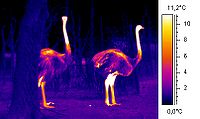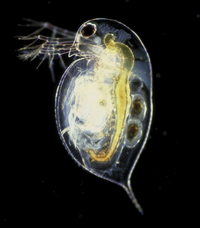
Cost‐saving population genomic investigation of Daphnia longispina complex resting eggs using whole‐genome amplification and pre‐sequencing screening
Sign Up to like & getrecommendations! Published in 2022 at "Ecology and Evolution"
DOI: 10.1002/ece3.9682
Abstract: Abstract Resting stages of aquatic organisms that accumulate in the sediment over time are an exceptional resource that allows direct insights into past populations and addressing evolutionary questions. This is of particular interest in taxa… read more here.
Keywords: genome amplification; daphnia longispina; resting eggs; daphnia ... See more keywords

Fish embryo tests and acute fish toxicity tests are interchangeable in the application of the threshold approach.
Sign Up to like & getrecommendations! Published in 2019 at "Environmental toxicology and chemistry"
DOI: 10.1002/etc.4351
Abstract: A database was compiled for algal Organisation for Economic Co-operation and Development (OECD) test guideline 201, for Daphnia magna OECD test guideline 202, for the acute fish toxicity (AFT) OECD test guideline 203, and for… read more here.
Keywords: fish toxicity; toxicity; daphnia; threshold approach ... See more keywords

Countergradient variation concealed adaptive responses to temperature increase in Daphnia from heated lakes
Sign Up to like & getrecommendations! Published in 2021 at "Limnology and Oceanography"
DOI: 10.1002/lno.11680
Abstract: To test the general assumption that global warming will induce body size reduction in aquatic organisms, we used a system of lakes continually heated for six decades by warm water discharge from power plants. Their… read more here.
Keywords: temperature; daphnia; size; body size ... See more keywords

Improving the proteome coverage of Daphnia magna ‐ implications for future ecotoxicoproteomics studies
Sign Up to like & getrecommendations! Published in 2022 at "PROTEOMICS"
DOI: 10.1002/pmic.202100289
Abstract: Aquatic pollution is an increasing problem and requires extensive research efforts to understand associated consequences and to find suitable solutions. The crustacean Daphnia is a keystone species in lacustrine ecosystems by connecting primary producers with… read more here.
Keywords: proteome coverage; daphnia; improving proteome; coverage daphnia ... See more keywords

Review on the ecotoxicological impacts of plastic pollution on the freshwater invertebrate Daphnia
Sign Up to like & getrecommendations! Published in 2022 at "Environmental Toxicology"
DOI: 10.1002/tox.23623
Abstract: The environmental impacts of plastic pollution have recently attracted universal attention, especially in the aquatic environment. However, research has mostly been focused on marine ecosystems, even though freshwater ecosystems are equally if not more polluted… read more here.
Keywords: freshwater; pollution; review; impacts plastic ... See more keywords

Interspecific variation in ephippial size between Daphnia galeata and D. pulicaria in Lake Biwa, Japan
Sign Up to like & getrecommendations! Published in 2020 at "Limnology"
DOI: 10.1007/s10201-020-00646-8
Abstract: Daphnia, keystone herbivores in lakes, routinely produce immediately hatching eggs; additionally, they also produce resting eggs enveloped by an ephippial case, a thickened carapace that allows population survival under harsh environmental conditions. To examine differences… read more here.
Keywords: galeata pulicaria; daphnia galeata; biwa japan; lake biwa ... See more keywords

Phenotypic plasticity and developmental noise in hybrid and parental clones of Daphnia longispina complex
Sign Up to like & getrecommendations! Published in 2021 at "Aquatic Ecology"
DOI: 10.1007/s10452-021-09898-7
Abstract: According to the “temporal hybrid superiority hypothesis”, seasonal variability in environmental factors in temperate lakes gives hybrid clones within the D. longispina complex a temporary fitness advantage, thus allowing long-term, dynamic coexistence of hybrids and… read more here.
Keywords: developmental noise; phenotypic plasticity; daphnia; longispina complex ... See more keywords

In vivo assessment of pathogens toxicity on Daphnia magna using fluorescent dye staining
Sign Up to like & getrecommendations! Published in 2020 at "Ecotoxicology"
DOI: 10.1007/s10646-020-02257-6
Abstract: Daphnia has been widely used as an indicator species in aquatic biomonitoring for decades. Traditional toxicity assays based on lethality take a long time to assess, and the effect mode of contaminants is not clear.… read more here.
Keywords: daphnia magna; assessment pathogens; daphnia; toxicity ... See more keywords

Anti-predator behaviour of native prey (Daphnia) to an invasive predator (Bythotrephes longimanus) is influenced by predator density and water clarity
Sign Up to like & getrecommendations! Published in 2019 at "Hydrobiologia"
DOI: 10.1007/s10750-019-03983-7
Abstract: Bythotrephes longimanus is an invasive zooplankton predator, negatively impacting zooplankton abundance and diversity in North American lakes. Previous studies have shown that Daphnia populations in lakes move to deeper waters during the day, in the… read more here.
Keywords: water; density; daphnia; predator ... See more keywords

Transgenic and cell wall-deficient Chlamydomonas reinhardtii food affects life history of Daphnia magna
Sign Up to like & getrecommendations! Published in 2019 at "Journal of Applied Phycology"
DOI: 10.1007/s10811-019-01983-7
Abstract: The economical interest in the use of genetically modified microalgae (GMM) increases because of their potential for low-cost industrial mass cultivation, high productivity (e.g., biomass, lipids, and recombinant proteins), and short generation times. However, the… read more here.
Keywords: daphnia; life history; chlamydomonas reinhardtii; daphnia magna ... See more keywords

Grazer-Induced Chemical Defense in a Microcystin-Producing Microcystis aeruginosa (Cyanobacteria) Exposed to Daphnia gessneri Infochemicals.
Sign Up to like & getrecommendations! Published in 2021 at "Journal of chemical ecology"
DOI: 10.1007/s10886-021-01315-5
Abstract: Cyanobacteria are photosynthetic microorganisms that compose phytoplankton and therefore have a trophic relationship with zooplankton, which represent an important link for energy flux in aquatic food webs. Several species can form blooms and produce bioactive… read more here.
Keywords: defense; daphnia; microcystis aeruginosa; chemical ... See more keywords